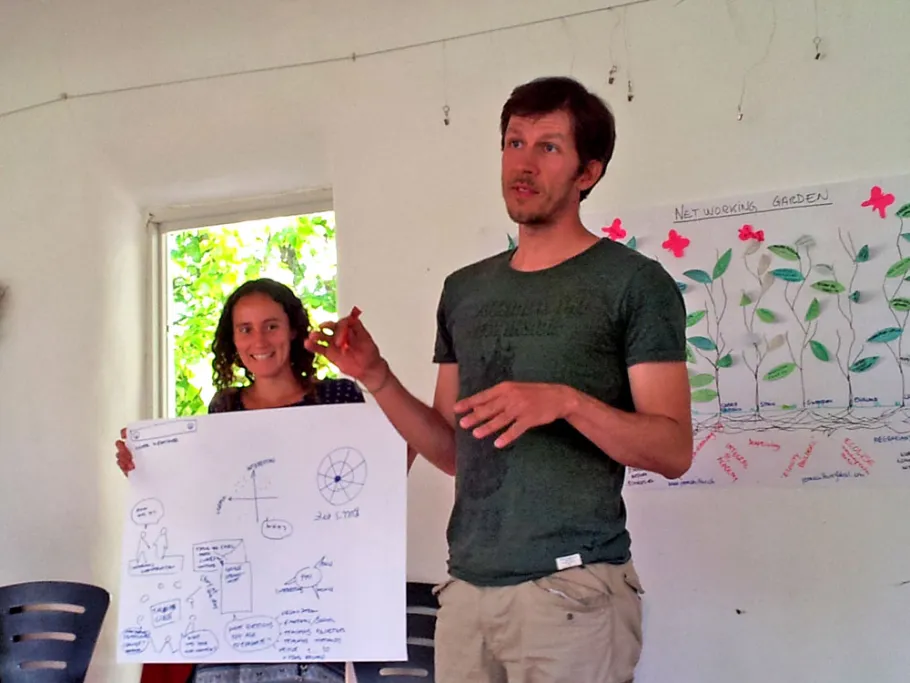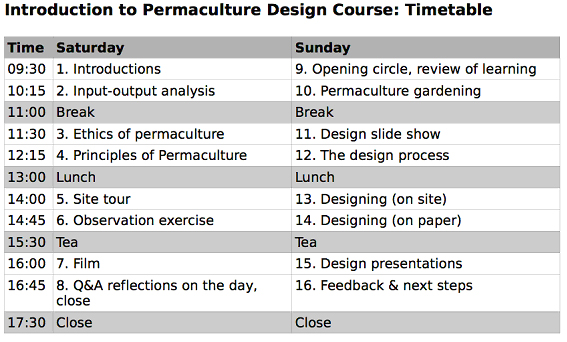
In this article I offer a “junior teacher's” perspective to selecting content and methods for a two day introductory course. I also asked Graham Bell, one of the most experienced permaculture teachers, his take on designing a full Permaculture Design Certificate (PDC) course.
See a separate article with timetable, core curriculum and Graham Bell's thoughts, here.
I see the intro as a taster, as a way to get people together and get inspired to learn more. The content for an Intro isn't “regulated” whereas the curriculum of a PDC is based on Bill Mollison's book Permaculture – A Designer's Manual.
My teaching context is Finland, a country where there had only been two or three PDCs and probably no intros by the time I started to teach permaculture in 2012. There are no permaculture books or course curricula in Finnish. I teach with a friend of mine. Co-teaching makes the course more fun and helps to share the workload.
Commonly, the weekend course we teach is from 10am - 5pm on both days, so there is 14 hours to use. Lunch breaks take 2 hours and there are two 20 minute coffee breaks a day. This arrangement leaves about 11 hours of actual teaching time. So, now the fun part. What to teach and how?
For our first course, we designed it by searching for existing course timetables. I, myself, have never been on an intro-course, so I referred to the content of the PDC I took. The British Permaculture Association offers a valuable Intro-course timetable on their webpage (download PDF):

We respected the experience that is behind this course schedule; it felt like a good starting point. We decided to keep the sessions that felt most essential: ethics, principles, observation and input/output analysis. Most of the Sunday is comprised of design sessions, but we decided to leave them out, because we felt as though they were more appropriate for a longer course such as a PDC. For an intro course, it is important to simply inspire your students to want to take the learning further. For our Sunday, we included local examples, harvesting experiences from the students with plenty of free time to talk about projects and interesting situations, plus a session on zones and sectors. Here is the current timetable we use. It evolves between each course and adapts to the venue, the number of participants and the time of year:
| Saturday 10:00 | Orientation | Sunday 10:00 | Forest garden in Finland, possibilities ann challenges. | |||
| 11 | 15min. | Break | Break | |||
| What is permaculture? | Design exercise: zones& sectors | |||||
| Design process and Input/Output analysis | Principles and ethics | |||||
| 13 | 60min. | Lunch | Lunch | |||
| Observation exercise | Participants' own projects | |||||
| 15 | 15min. | Break | Break | |||
| Movie: A Farm for the Future + discussion | Social permaculture. Next steps and closing |
Most sessions happen inside. Outdoor sessions are included everyday especially after the lunch when people are often a bit too tired to take lectures inside. There aren't many lectures included in general but participatory methods are mainly used. As there is two teachers we often divide the group (max.20) and do exercises in smaller groups. Graham Bell has taught permaculture for over 25 years and has huge experience in designing and running courses.
I met Graham in 2013 and got immediately fascinated by his ability to tell stories and inspire people around him. Here he shares some of his visions of teaching permaculture: "We work off this as a basis:
Agreed curriculum and a timetable which we hope delivers poetry. Inspiration. Love & Longing. But competent starting points. This timetable is adjusted for every audience we teach.
You always have to tailor the end result to the participants. So – for example- we tend to be swayed to the climate zone we are in. But you also need to teach what happens in other climate zones. But biased to the needs of the people you have there.
72 hours is a tiny amount of time to deliver the core curriculum. So don’t try and fill people full of facts. Inspire them to learn more and give them a basic understanding of how it all fits together.
It’s all about empowerment. But we can’t empower anyone. All we can do is create the right environment for them to empower themselves. Hungry people seek out food- people hungry for knowledge seek out just that.
I love to teach here in Garden Cottage where people can SEE twenty five years’ experience. But there’s a power to the course and the curriculum so even folks who have no site and precious little experience seem able to inspire others. I have views on the justice of effort and rewards but that’s another matter.
In the words of Bill Mollison 'I don’t think I can save the world on my own. I think it’ll take three of us.' "
- Joel Rosenberg, 2014
- Log in to post comments
